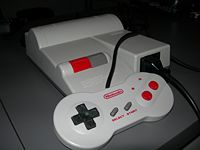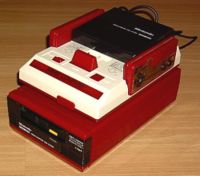Nintendo Entertainment System console information

Nintendo Entertainment System console

Nintendo Entertainment System logo
| Generation | Third (8 bit era) |
| First Avaible | North America: October 18, 1985 |
| Controller input | 2 controller ports, 1 expansion slot |
| Units sold | 60 Million |
| Top selling game | Super Mario Bros. |
| Predsessor | Color TV game |
| Sucsessor | Super Nintendo Entertainment System |
The Nintendo Entertainment System (often referred to as the NES or simply Nintendo) is an 8-bit video game console released by Nintendo in North America, Brazil, Europe, and Australia in 1985. In most of Asia, including Japan (where it was first launched in 1983), the Philippines, Taiwan, Vietnam, and Singapore, it was released as the Family Computer or simply, the Famicom listen. In South Korea, the hardware was licensed to Hyundai Electronics, which marketed it as the Comboy. The most successful gaming console of its time in Asia and North America (Nintendo claims to have sold over 60 million NES units worldwide), it helped revitalize the US video game industry following the video game crash of 1983. It set the standard for subsequent consoles in everything from game design (the breakthrough platform game, Super Mario Bros., was the systemís first major success) to controller layout. The NES was the first console for which the manufacturer openly courted third-party developers. The slogan for the NES in North America is "Now You're Playing With Power!"
History
Following a series of arcade game successes in the early 1980s, Nintendo made plans to produce a cartridge-based console. Masayuki Uemura designed the system, which was released in Japan on July 15, 1983 for •14,800 alongside three ports of Nintendoís successful arcade games Donkey Kong, Donkey Kong Jr., and Popeye. The Nintendo Family Computer (Famicom) was slow to gather momentum; during its first year, many criticized the system as unreliable, prone to programming errors and rampant freezing. Following a product recall and a reissue with a new motherboard, the Famicomís popularity soared, becoming the best-selling game console in Japan by the end of 1984.In Europe and Australia, the system was released to two separate marketing regions (A and B). Distribution in region B, consisting of most of mainland Europe (excluding Italy), was handled by a number of different companies, with Nintendo responsible for most cartridge releases; most of region B saw a 1986 release. Mattel handled distribution for region A, consisting of the United Kingdom, Ireland, Italy, Australia and New Zealand, starting the following year. Not until 1990 did Nintendoís newly created European branch take over distribution throughout Europe. Despite the systemís lackluster performance outside of Japan and North America, by 1990 the NES had outsold all previously released consoles.

The NES 2
Bundle Packages
For its North American release, the NES was released in two different configurations, or "bundles". The console deck itself was identical, but each bundle was packaged with different Game Paks and accessories. The first of these sets, the Control Deck, retailed from US$199.99, and included the console itself, two game controllers, and a Super Mario Bros. game cartridge. The second bundle, the Deluxe Set, retailed for US$249.99, and consisted of the console, a R.O.B., a NES Zapper (electronic gun), and two game paks: Duck Hunt and Gyromite.
Regional differences
 Although the Japanese Famicom and the international NES included essentially
the same hardware, there were certain key differences between the two systems:
Although the Japanese Famicom and the international NES included essentially
the same hardware, there were certain key differences between the two systems:
